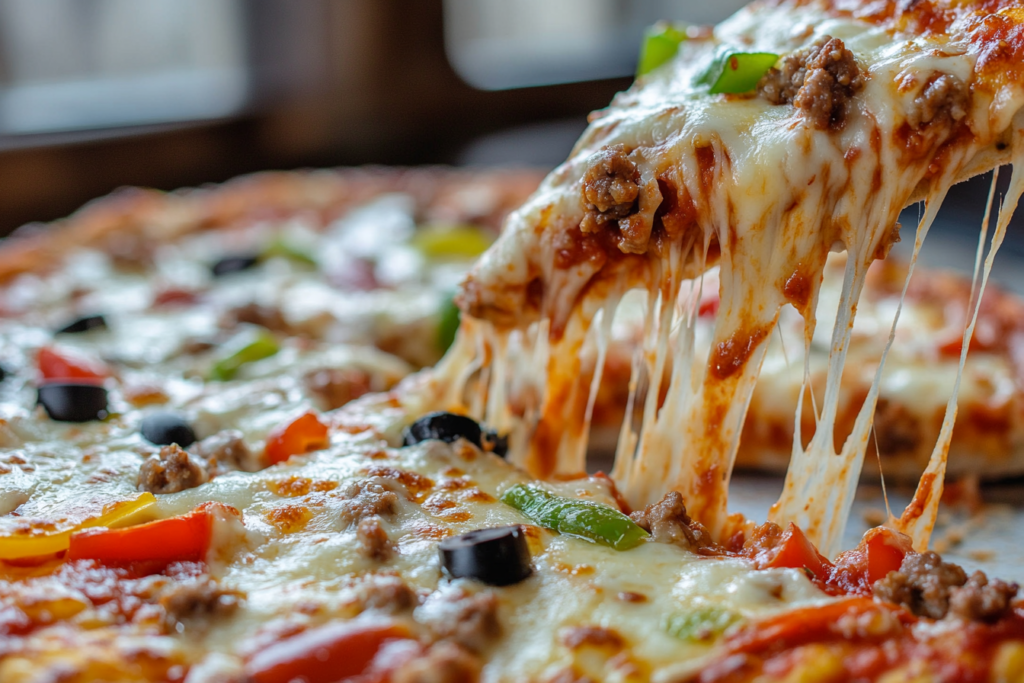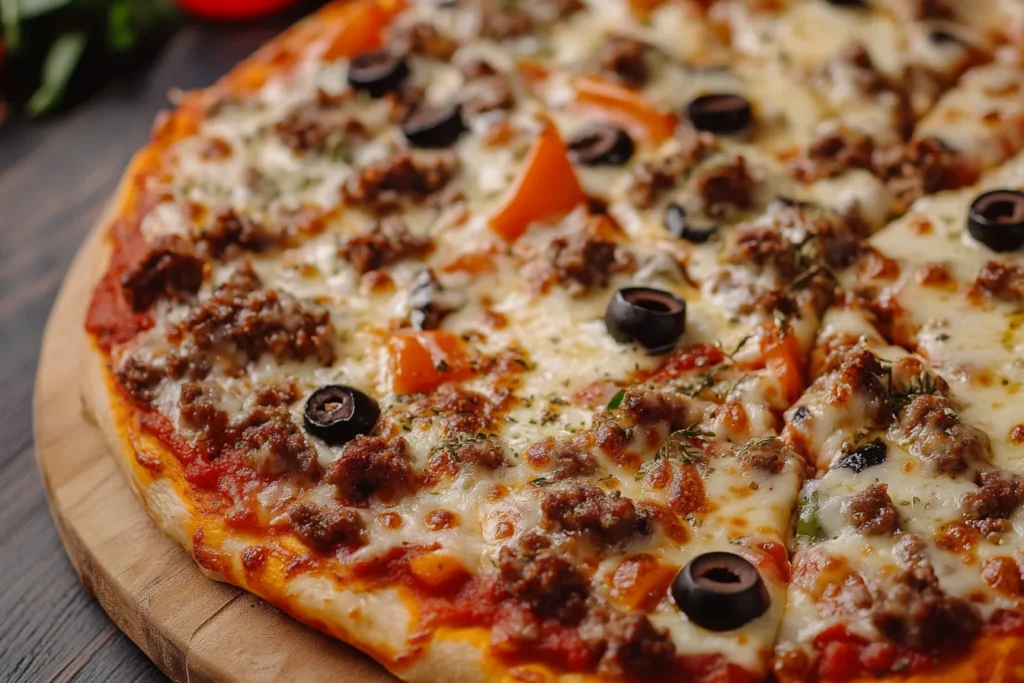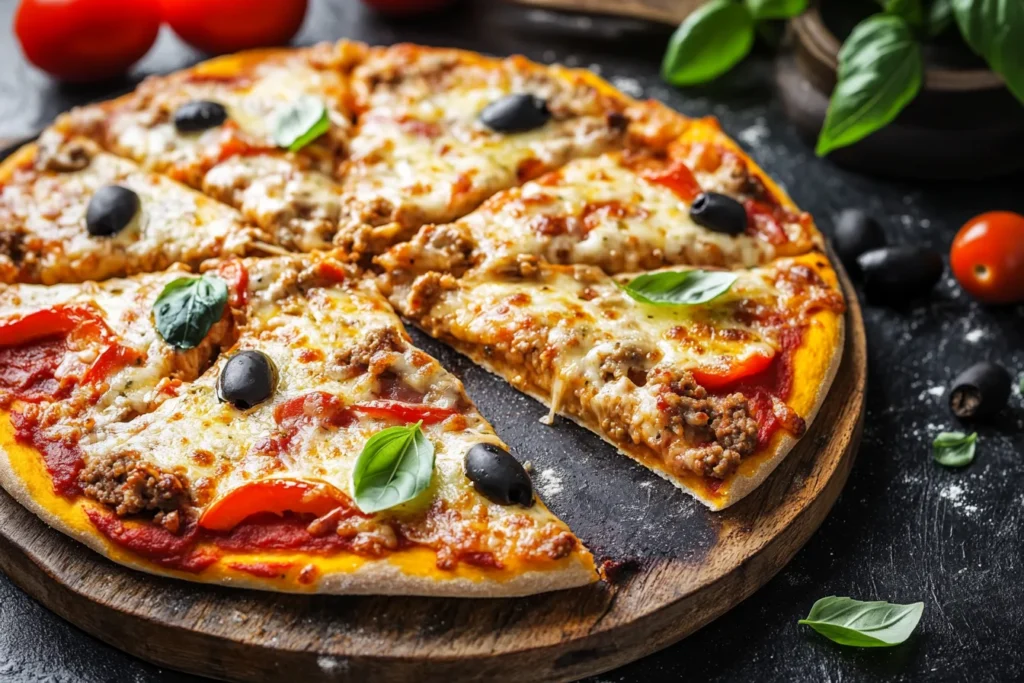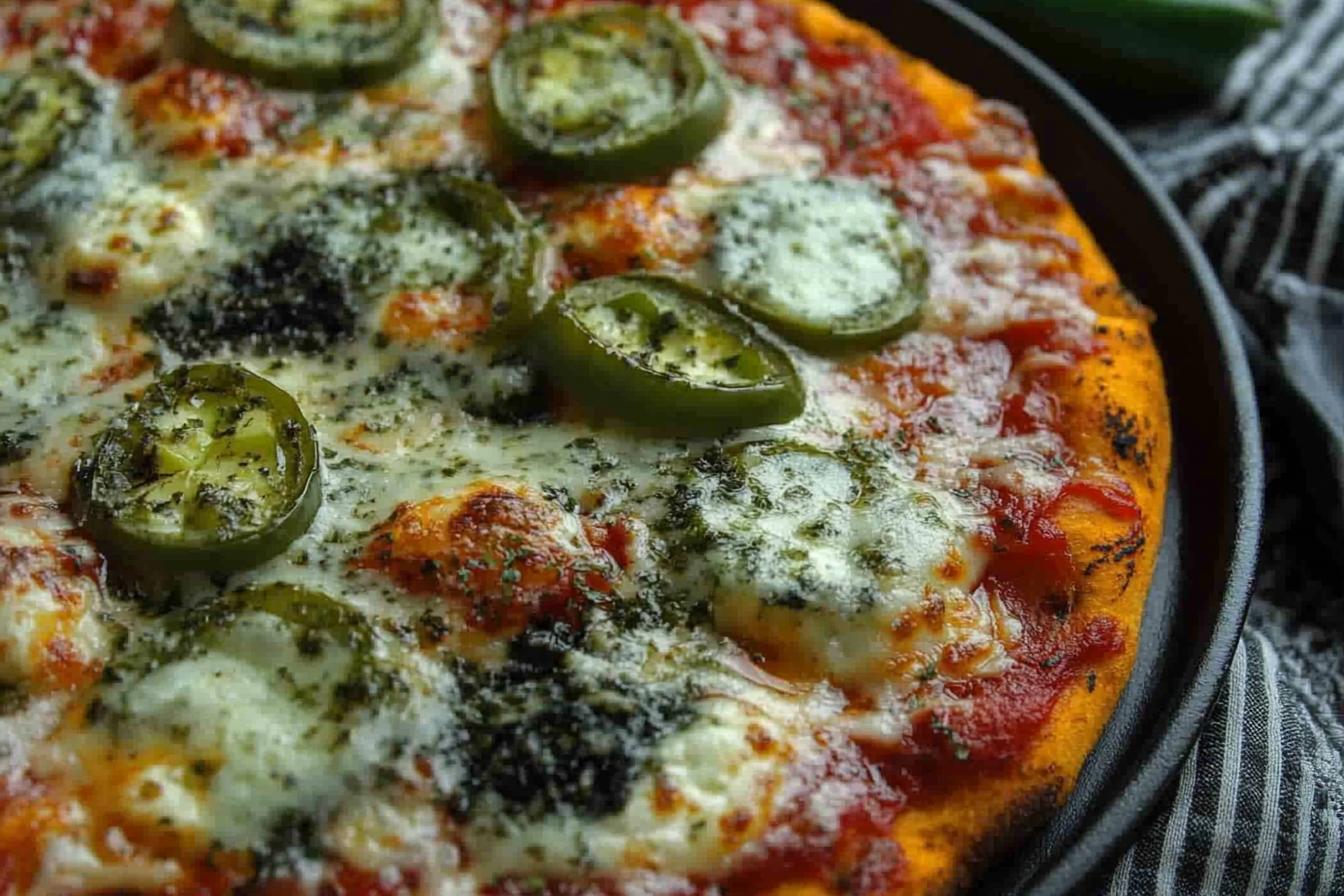Paneer pizza combines the creamy, rich flavors of paneer with the savory satisfaction of traditional Italian pizza. It’s a cultural fusion that satisfies diverse palates, bringing together the best of both worlds.
What is Paneer Pizza?
Paneer pizza is a delightful culinary creation that uses Indian paneer (cottage cheese) as the star topping. This twist on traditional pizza resonates with food enthusiasts who crave innovative yet comforting meals. The soft, chewy texture of paneer pairs beautifully with gooey cheese, crispy crusts, and bold spices, making it a unique and versatile dish.
Popularity of Paneer as a Topping
Paneer is beloved across India for its adaptability. Its mild flavor makes it the perfect canvas for bold marinades like tandoori masala or spicy chili. When layered on a pizza, it acts as both a protein source and a flavor powerhouse, elevating the dish into something extraordinary.
Pro Tip: The combination of paneer with colorful vegetables like bell peppers and onions adds an extra burst of flavor and visual appeal.

Essential Ingredients for Paneer Pizza
1. Types of Paneer for Pizza
The choice of paneer can make or break your pizza. Opt for:
- Fresh, soft paneer for creaminess.
- Pre-marinated options if you’re short on time.
2. Fresh Vegetables
Including vegetables such as bell peppers, onions, and tomatoes enhances both texture and flavor. These vegetables provide crunch and complement the richness of paneer.
3. Pizza Base Options
You can choose between:
- Store-bought bases: Convenient and time-saving.
- Homemade dough: Offers a personalized touch and superior taste.
For the best results, experiment with a whole-grain base to add a nutritious edge to your pizza.
Making the Perfect Pizza Base
Ingredients for a Homemade Pizza Base
Creating your own base is simple and requires a few pantry staples:
- 2 ½ cups of all-purpose flour or whole wheat flour.
- 1 tsp sugar.
- 1 tsp salt.
- 1 tbsp olive oil.
- 1 packet (7g) of active dry yeast.
Step-by-Step Guide to Preparing the Dough
- Activate the yeast by mixing it with warm water and sugar. Let it sit until foamy.
- Combine the flour, salt, and olive oil, then gradually add the yeast mixture.
- Knead until you have a smooth dough. Cover it with a damp cloth and let it rise for an hour.
- Roll it out to your desired thickness.
Thin Crust vs. Thick Crust
- A thin crust crisps up beautifully and enhances toppings like paneer.
- A thick crust is chewy and great for those who enjoy a heartier pizza.
Preparing Paneer for Pizza
1. Marinating the Paneer Cubes
Marinating paneer is essential for infusing it with flavor.
Simple Marinade Recipe:
- 1 tbsp yogurt.
- 1 tsp tandoori masala.
- ½ tsp turmeric.
- ½ tsp chili powder.
- 1 tbsp lemon juice.
2. Popular Marinades
For variation, try:
- Tandoori-style marinade for smoky flavors.
- Spicy masala marinade for bold, fiery notes.
3. Cooking the Paneer
Before placing paneer on the pizza, cook it slightly to lock in its moisture:
- Grilled Paneer: Gives a smoky flavor and firm texture.
- Fried Paneer: Soft and creamy, with crispy edges.
Pizza Sauce Selection
1. Classic Tomato Pizza Sauce
A traditional tomato-based sauce forms the perfect base for your paneer pizza.
Quick Recipe: Sauté onions, garlic, and tomatoes. Blend with oregano, chili flakes, and a dash of olive oil.
2. Spicy Indian Masala Sauce
For an Indian twist, prepare a masala sauce with:
- Tomatoes.
- Ginger-garlic paste.
- Garam masala and chili powder.
3. Pre-Made Sauces
If using store-bought options, choose those free from added sugars and artificial flavors.
Cheese Choices for Paneer Pizza
1. Mozzarella as the Primary Cheese
Mozzarella’s meltability and creamy texture make it a must-have for pizza.
2. Combining Cheeses for Flavor Depth
Mix mozzarella with:
- Parmesan for sharpness.
- Cheddar for richness.
3. Vegan Cheese Options
For plant-based eaters, vegan mozzarella or cashew-based cheeses are great substitutes.
Paneer Pizza Recipe: Assembling and Perfecting the Dish
Continuing from Part 1, let’s dive into the exciting process of assembling, baking, and customizing your paneer pizza. This section focuses on getting the perfect balance of toppings, achieving the ideal bake, and exploring variations to keep your recipe fresh and exciting.

Assembling the Paneer Pizza
Creating the perfect paneer pizza is all about precision and balance.
1. Spreading the Sauce Evenly
The sauce is the foundation of your pizza’s flavor. Spread it evenly across the base, leaving about an inch around the edges for the crust.
Pro Tip: Use the back of a spoon to ensure consistent coverage. If using a spicy masala sauce, be mindful of the spice level so it doesn’t overpower other toppings.
2. Layering Paneer and Vegetables
Follow these steps for the perfect topping distribution:
- Start with a thin layer of mozzarella.
- Evenly distribute the marinated paneer cubes across the pizza.
- Add vegetables like onions, bell peppers, and tomatoes for a colorful, crunchy finish.
Pro Tip: Avoid piling on too many toppings as it can make the crust soggy.
3. Adding Cheese for the Best Melt
Top your pizza with another layer of cheese for that gooey, irresistible finish. A combination of mozzarella and cheddar works wonders for flavor depth.
Baking the Paneer Pizza
1. Oven Temperature and Preheating
Preheating your oven is crucial for a perfectly baked pizza.
- Set your oven to 450°F (230°C).
- Allow it to preheat for at least 20 minutes to ensure even cooking.
2. Baking Time Guidelines
- Thin crust: Bake for 10-12 minutes or until the edges are golden.
- Thick crust: Bake for 15-18 minutes, ensuring the center is cooked through.
Pro Tip: Keep an eye on the cheese. It should melt evenly without burning.
3. Using a Pizza Stone vs. Baking Sheet
- A pizza stone absorbs moisture, giving your crust a crispy, restaurant-style finish.
- A baking sheet is a more accessible option, perfect for casual home cooks.
Tips for a Crispy Crust
Getting that crispy yet tender crust requires attention to detail.
1. Using Cornmeal on the Base
Dusting your baking surface with cornmeal prevents sticking and adds a delightful crunch to the crust.
2. Adjusting Oven Racks for Optimal Heat Distribution
Place the pizza on the middle rack for even heat exposure. For an extra crispy bottom, move it to the lower rack during the last 2-3 minutes of baking.
3. Post-Baking Techniques
After baking, let the pizza rest for a minute or two. This helps the toppings set and makes slicing easier.
Popular Paneer Pizza Variations
Experimenting with variations ensures you never get bored of this dish.
1. Tandoori Paneer Pizza
This variation features paneer marinated in tandoori masala, layered with onions, and topped with a spicy yogurt drizzle.
2. Paneer Tikka Pizza
Paneer tikka cubes paired with capsicum and red onions bring a smoky, grilled flavor to your pizza.
3. Cheesy Paneer and Veggie Deluxe Pizza
For cheese lovers, this version piles on multiple cheese varieties along with paneer, mushrooms, olives, and bell peppers for a hearty, deluxe experience.
Creative Tips to Elevate Your Paneer Pizza
1. Garnishing with Fresh Herbs
Add freshness and aroma by garnishing with cilantro, basil, or parsley just before serving.
2. Adding a Drizzle of Sauce
Drizzle a bit of spicy mayo, tangy barbecue sauce, or herb-infused olive oil over the top for extra flavor.
3. Pairing Paneer Pizza with Drinks
Complement the rich flavors of paneer pizza with:
- Sparkling lemonade for a refreshing contrast.
- Iced tea with a hint of lemon and mint.
Paneer Pizza Recipe: Serving, Storage, and Health Benefits
In this final part, we’ll focus on the serving experience, how to adapt your recipe for special diets, proper storage techniques, and the health benefits of paneer pizza. Let’s ensure your creation shines every time you serve it!
Serving Paneer Pizza
The way you serve and present your paneer pizza can elevate the dining experience.
1. Presentation Tips
- Slice your pizza into equal portions using a pizza cutter for a professional finish.
- Serve on wooden boards or stone platters for an authentic pizzeria vibe.
- Arrange toppings like fresh herbs, olives, or thinly sliced chilies after baking to add a pop of color.
2. Garnishing with Herbs
Fresh herbs like cilantro, basil, or oregano add a vibrant touch. Sprinkle these just before serving to enhance aroma and flavor.
3. Pairing Paneer Pizza with Drinks
Pairing drinks with your pizza makes the meal more enjoyable:
- For spicy variations: Cool it down with a mango lassi or a chilled soda.
- For classic paneer pizza: Serve with a light red wine or sparkling water with lemon.
Paneer Pizza for Special Diets
Modifying your recipe ensures everyone can enjoy it, regardless of dietary restrictions.
1. Gluten-Free Paneer Pizza Options
- Use gluten-free flours like almond, rice, or chickpea to make the pizza base.
- Store-bought gluten-free bases are convenient but check for preservatives.
2. Vegan Adaptations
- Replace paneer with tofu, marinated in the same spices for a similar texture.
- Use vegan mozzarella made from cashews or coconut for a creamy, cheesy layer.
3. Low-Calorie Modifications
- Use a whole-wheat or cauliflower crust to reduce carbs.
- Replace some of the cheese with grated zucchini or carrots for a lighter alternative.
Pro Tip: Bake at a slightly lower temperature to ensure these alternatives don’t dry out.
Storage and Reheating
Proper storage and reheating techniques ensure your pizza tastes just as good the next day.
1. Proper Storage Techniques
- Let the pizza cool completely before storing to avoid sogginess.
- Wrap slices individually in foil or store in airtight containers to retain freshness.
- Refrigerate for up to 3 days or freeze for up to 2 months.
2. Reheating Methods to Retain Freshness
- Oven: Reheat at 350°F (175°C) for 8-10 minutes for a crispy crust.
- Stovetop: Use a skillet on low heat with a lid for 5-7 minutes. This keeps the crust crisp and the cheese melted.
- Microwave: A quick option, but place a cup of water inside the microwave to prevent the pizza from becoming rubbery.
3. Shelf-Life Considerations
- Freshly made pizza lasts longer when stored properly.
- Avoid reheating multiple times as this can degrade the texture and taste of paneer.
Common Mistakes to Avoid
1. Overcooking the Paneer
Overcooked paneer becomes tough and rubbery. Always cook it lightly before adding it to the pizza.
2. Uneven Layering of Ingredients
Distribute toppings evenly to prevent some parts from being overloaded while others are bare.
3. Burnt Crust Issues
Ensure your oven temperature is accurate, and keep a close watch during the last few minutes of baking.
Health Benefits of Paneer Pizza
Eating paneer pizza can be both indulgent and nutritious when prepared thoughtfully.
1. Nutritional Value of Paneer
Paneer is rich in:
- Protein: Supports muscle repair and growth.
- Calcium: Strengthens bones and teeth.
- Healthy Fats: Provides energy and aids nutrient absorption.
2. Incorporating Vegetables for Balanced Meals
Vegetables like bell peppers, onions, and tomatoes add vitamins, antioxidants, and fiber, making your pizza a wholesome option.
3. Using Whole-Grain Pizza Base for Added Fiber
Switching to a whole-grain or multigrain base increases the fiber content, aiding digestion and keeping you full longer.
Conclusion and Final Thoughts
Making paneer pizza at home is not just about recreating a dish; it’s about experiencing the joy of creativity in the kitchen. The combination of flavors, textures, and the cultural fusion of Indian and Italian cuisines make this recipe a crowd-pleaser.
Encourage experimentation—try new marinades, play with toppings, or adapt the recipe for dietary needs. Cooking is as much about discovery as it is about taste.
Share your unique takes on this recipe with family and friends, and let your paneer pizza tell a story of fusion and flavor.

More FAQs
- Can I make paneer pizza without an oven?
Yes, you can use a stovetop method with a covered skillet or a tawa for baking. - What is the best substitute for paneer in this recipe?
Tofu is an excellent substitute, especially for vegan adaptations. - Can I use store-bought marinades for paneer?
Absolutely! Pre-made marinades save time and come in diverse flavors. - How do I prevent my pizza base from becoming soggy?
Pre-bake the base for 5 minutes before adding sauce and toppings. - What’s the ideal cheese-to-paneer ratio?
Use 2 parts cheese to 1 part paneer for a balanced flavor. - Can I use frozen paneer for pizza?
Yes, just thaw it completely and press out excess moisture before use. - What’s the best way to reheat pizza without drying it out?
Use a skillet or oven with a lid to retain moisture while reheating. - How can I make the crust softer?
Add a little milk to your dough recipe for a tender crust. - What’s the difference between paneer tikka pizza and tandoori paneer pizza?
Paneer tikka pizza uses grilled tikka-style cubes, while tandoori paneer has a smoky, spiced marinade. - Can I freeze leftover pizza dough?
Yes, divide it into portions, wrap in plastic wrap, and freeze for up to 3 months.

